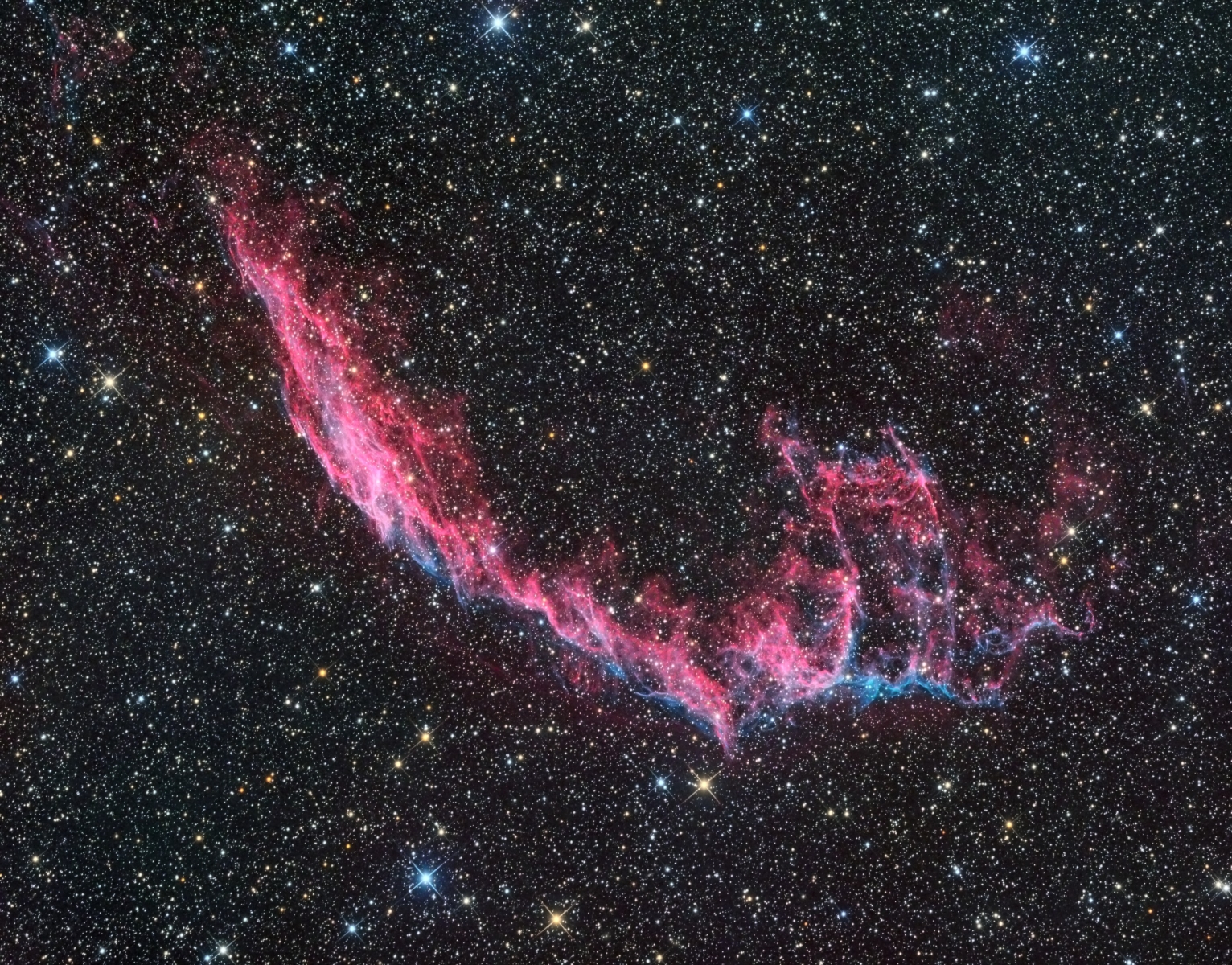NGC6992, Eastern Veil Nebula
Click image for full size version
January 23, 2015; Astronomy Magazine Picture of the Day, September 30, 2015
 This shot shows the Eastern Veil Nebula set in the rich background of the Milky Way. It complements images that I have taken of Pickering’s Triangle on its own and with the Western Veil Nebula, and NGC6979, all of which are other portions of this huge supernova remnant. You can zoom in on the knots and braids of glowing gas in the Veil Nebula. They are really beautiful, glowing red due to hydrogen and blue/green due to oxygen.
This shot shows the Eastern Veil Nebula set in the rich background of the Milky Way. It complements images that I have taken of Pickering’s Triangle on its own and with the Western Veil Nebula, and NGC6979, all of which are other portions of this huge supernova remnant. You can zoom in on the knots and braids of glowing gas in the Veil Nebula. They are really beautiful, glowing red due to hydrogen and blue/green due to oxygen.
Tekkies:
SBIG STL-11000M camera, Baader LRGB filters, 10″ f/3.6 ASA astrograph, MI-250 mount. Guided with STL-11000’s internal guider. Focus with FocusMax. Acquistion, guiding, calibration, in Maxim-DL. All other processing in PixInsight. Shot from my SkyShed in Guelph, Ontario. Average transparency and average or below average seeing. Gibbous moon.
9x10m R,G and B for a total of 4hr30m RGB. 7x20m Ha 2hr20m Ha. Total exposure time was 6 hr50m over 3 nights
Synthetic Luminance:
Creation and cleanup: The R,G,B and Ha masters were combined using the ImageIntegration tool (average, additive with scaling, noise evaluation, iterative K-sigma / biweight midvariance, no pixel rejection). DBE was applied to neutralize the background.
Deconvolution: A star mask was made to use as a local deringing support. A copy of the image was stretched to use as a range mask. Deconvolution was applied (75 iterations, regularized Richardson-Lucy, external PSF made using DynamicPSF tool with about 40 stars).
Stretching: HistogramTransformation was applied.
Ha, R, G and B masters were cropped to remove edge artifacts from stacking. The R, G and B channels were combined to make an RGB image. Ha and RGB were processed with DBE, combined with the NB-RGB script, and Colour Calibration was applied. HistogramTransformation was applied, with the goal being to approximately match the brightness of the HaRGB to the SynthL image made previously.
Combining SynthL with HaRGB:
The luminance was extracted from the HaRGB image, processed and then added back into the HaRGB image as follows:
1. Extract luminance from the HaRGB image.
2. Apply LinearFit using the SynthL channel as a reference.
3. Use ChannelCombination in the Lab mode to replace the luminance of the HaRGB with the fitted luminance from step 2.
4. Use LRGBCombine to appl SynthL to the HaRGB image.
Additional Processing
Noise Reduction and Re-Stretch: TGVDenoise was applied in RGB/K mode with 300 iterations with a range mask used to protect nebula and stars. This was followed by a HistogramTransformation to raise the black point (but with no clipping).
Star Reduction and Colour Adjustment: Morphological transformation (3×3, 3 iterations, strength 0.1) was applied using a star mask to protect background and nebula. Luminance was extracted from the image and LinearMultiscaleTransform was applied to extract the first 4 wavelet layers (no residual). This image was used as a mask when applying ColourSaturation to boost colour in the star cores.
Final Steps: The deconvolution Deringing Support mask was used to apply MorphologicalTransformation to only the brightest stars (3 iteration; strength 0.1). A contrast adjustment and colour saturation tweak was applied. The deconvolution Deringing Support mask was used to apply deconvolution in the motion blur mode (Regularized Richardson-Lucy, 20 iterations, length=5, angle=90, dark deringing just enough to eliminate dark edges on stars). ACDNR was run to very slightly smooth the background and dimmest parts of the nebula (L=0.5; chrom=0.8) using a very heavy mask to protect all but the darkest portion of the image.
Image scale is about 2.2 arcsec per pixel for this camera / telescope combination.







Leave A Comment